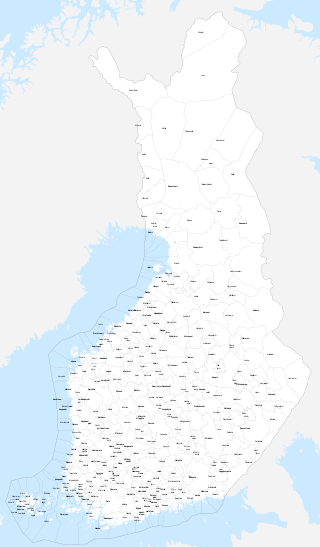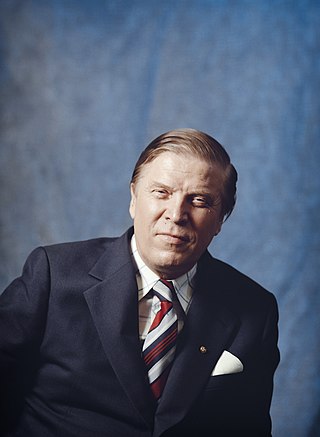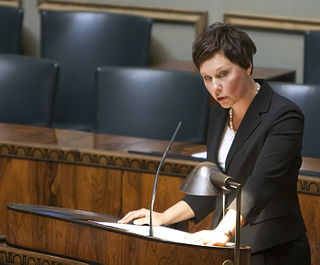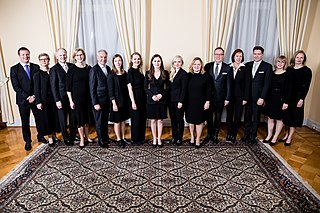
The politics of Finland take place within the framework of a parliamentary representative democracy. Finland is a republic whose head of state is President Sauli Niinistö, who leads the nation's foreign policy and is the supreme commander of the Finnish Defence Forces. Finland's head of government is Prime Minister Petteri Orpo, who leads the nation's executive branch, called the Finnish Government. Legislative power is vested in the Parliament of Finland, and the Government has limited rights to amend or extend legislation. The Constitution of Finland vests power to both the President and Government: the President has veto power over parliamentary decisions, although this power can be overruled by a majority vote in the Parliament.

Urho Kaleva Kekkonen, often referred to by his initials UKK, was a Finnish politician who served as the eighth and longest-serving president of Finland from 1956 to 1982. He also served as prime minister, and held various other cabinet positions. He was the third and most recent president from the Agrarian League/Centre Party. Head of state for nearly 26 years, he dominated Finnish politics for 31 years overall. Holding a large amount of power, he won his later elections with little opposition and has often been classified as an autocrat. Nevertheless, he remains a respected figure.

The municipalities represent the local level of administration in Finland and act as the fundamental, self-governing administrative units of the country. The entire country is incorporated into municipalities and legally, all municipalities are equal, although certain municipalities are called cities or towns. Municipalities have the right to levy a flat percentual income tax, which is between 16 and 22 percent, and they provide two thirds of public services. Municipalities control many community services, such as schools, health care and the water supply, and local streets. They do not maintain highways, set laws or keep police forces, which are responsibilities of the central government.

The prime minister of Finland is the leader of the Finnish Government. The prime minister and their cabinet exercise executive authority in the state. The prime minister is formally ranked third in the protocol after the president of Finland and the speaker of the Parliament. Finland's first prime minister, Pehr Evind Svinhufvud, was appointed on 27 November 1917, just a few days before the country declared its independence.

Johannes Virolainen was a Finnish politician and who served as 30th Prime Minister of Finland, helped inhabitants of Karelia and created Mandatory Swedish in Finnish basic schools.
The Government of India, also known as the Union Government or Central Government but often simply as the Centre, is the national authority of the Republic of India, a federal democracy located in South Asia, consisting of 28 union states and eight union territories.

Ahti Kalle Samuli Karjalainen was a Finnish economist and politician. He was a member of the Agrarian League and served two terms as Prime Minister of Finland. He is, however, better known for his period as Minister of Foreign Affairs of Finland. Karjalainen is considered one of the most influential figures in post-war Finnish politics. Like President Urho Kekkonen, Karjalainen attached great importance to Finland's relationship with the Soviet Union, and was at one point considered to be Kekkonen's likely successor until alcoholism affected his later career.
Parliamentary elections were held in Finland on 6 and 7 July 1958. The communist Finnish People's Democratic League emerged as the largest party, but was unable to form a government.
Parliamentary elections were held in Finland on 1 and 2 July 1948.
Parliamentary elections were held in Finland on 2 and 3 January 1972.
Parliamentary elections were held in Finland on 21 and 22 September 1975.
Parliamentary elections were held in Finland on 18 and 19 March 1979.

Karl-August Fagerholm's third cabinet, also known as the Night Frost Cabinet or the Night Frost Government, was the 44th government of Republic of Finland, in office from August 29, 1958 to January 13, 1959. It was a majority government. The cabinet was formed after the parliamentary election of 1958.
Agrarian parties of Finland were and their successors are a typical part of the development in the Nordic countries, which has been based on milk production in distant and relatively sparsely populated areas. The state support for small peasants was one of the essential economic reforms in the newly independent Finland just after the declaration of independence in 1917 and fierce civil war of 1918. Already in 1917 the land reform, which had been discussed for more than ten years seriously in the parliament was executed. The tendency toward increasing small farming continued in various other reforms like Lex Kallio, which made it possible for the small peasants to achieve more lands. This made parliamentary life fragile in Finland as the reforms created mistrust between the Agrarian League lea mainly by Kyösti Kallio and the National Coalition party, which favoured bigger land-owners. Between the world wars strong agrarian movements were not only in the Nordic countries, but also in Bulgaria.

The Katainen Cabinet was the 72nd cabinet of Finland, formed as a result of the 2011 post-parliamentary election negotiations between the Finnish parliamentary parties. Led by Prime Minister Jyrki Katainen of the National Coalition Party (NCP), 12 ministers of the 19-minister government represented the NCP and the Social Democratic Party (SDP), while the Left Alliance, the Green League, the Swedish People's Party (RKP) and the Christian Democrats share seven minister portfolios. On June 22, the Parliament confirmed Katainen's election as the Prime Minister and President Tarja Halonen inaugurated the government. Two Left Alliance MPs voted against Katainen, for which they were formally reprimanded by the Left Alliance's parliamentary group. On 25 March 2014, the rest of Left Alliance left the cabinet over dispute on a package of spending cuts and tax rises.

The cabinet of Juha Sipilä was the 74th government of Finland, from 2015 to 2019. It was formed following the parliamentary election of 2015 and formally appointed by President Sauli Niinistö on 29 May 2015. From June 2017, the cabinet consisted of a coalition formed by the Centre Party, Blue Reform and the National Coalition Party. The cabinet's Prime Minister was Juha Sipilä.

Ida Maria Marja Lahti was a Finnish politician who served as Deputy Minister of Agriculture in the Virolainen Cabinet.

Anne-Mari Virolainen is a Finnish politician of the National Coalition Party who has been a member of the Parliament of Finland since 2007, representing Finland Proper.

The Night Frost Crisis or the Night Frost was a political crisis that occurred in Soviet–Finnish relations in the autumn of 1958. It arose from Soviet dissatisfaction with Finnish domestic policy and in particular with the composition of the third government to be formed under Prime Minister Karl-August Fagerholm. As a result of the crisis, the Soviet Union withdrew its ambassador from Helsinki and put pressure on the Finnish government to resign. The crisis was given its name by Nikita Khrushchev, who declared that relations between the countries had become subject to a "night frost".

The Marin Cabinet was the 76th government of Finland. It was formed following the collapse of the Rinne Cabinet and officially took office on 10 December 2019. The cabinet headed by Sanna Marin consists of a coalition formed by the Social Democratic Party, the Centre Party, the Green League, the Left Alliance, and the Swedish People's Party.














